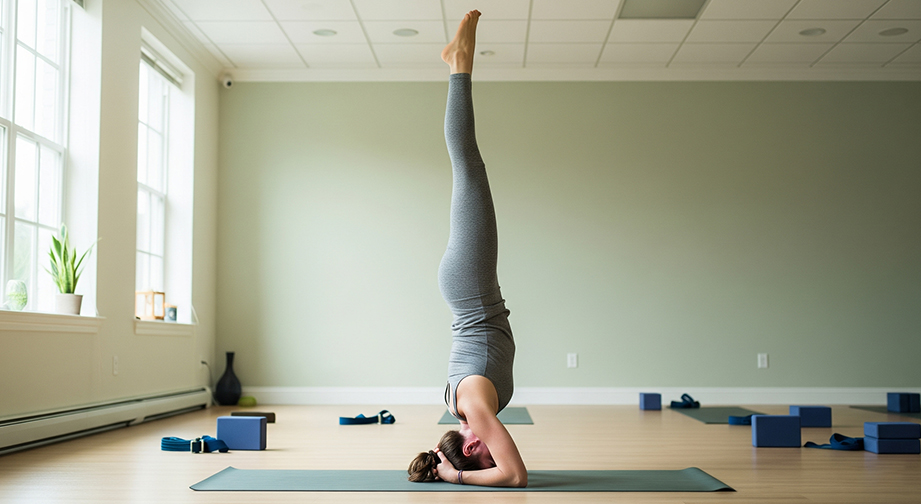Shirshasana / Kapalasana (Headstand): How to Master the Yoga Headstand Pose
Introduction
Have you ever watched someone balancing upside down and thought, “Wow! I could never do that!”? Well, you’re not alone. Shirshasana (also known as Kapalasana or the Yoga Headstand Pose) might look intimidating, but with gentle practice, this inversion posture becomes accessible and rewarding for yogis of all levels.
The Sanskrit word Shirshasana breaks down as: Shirsha (“head”) + asana (“pose” or “posture”). The essence of this asana is energizing and deeply balancing.
If you’ve ever felt tired, sluggish, or stuck in a creative rut, this pose could become your best friend—literally helping you see the world from a new perspective!
Step-by-Step Guide: How to Do Shirshasana (Yoga Headstand Pose)

- Preparation: Start with a gentle warm-up—Cat-Cow, Downward Dog, and Child’s Pose.
- Set Up: Kneel down on your mat. Interlace your fingers, forming a triangle base with your forearms flat on the mat. The tops of your pinkies can gently touch the mat.
- Head Placement: Place the crown of your head (not your forehead!) onto the mat, cupping the back of your head with your entwined hands.
- Inhaling: Tuck your toes and slowly lift your knees off the mat, straightening your legs. Walk your feet closer toward your head and base.
- Exhaling: Engage your core, lift one leg at a time (or both, if comfortable) off the floor.
- Alignment: Stack your hips above your shoulders, feet above hips. Gently straighten both legs upward toward the ceiling. Breathe smoothly—don’t hold your breath.
- Hold: Stay for 5–10 slow, deep breaths (20–60 seconds). Beginners can try 2–3 rounds of shorter holds (5–10 seconds each).
- To come down: Exhale, slowly lower one or both legs, return to Child’s Pose and rest.
Modifications for Beginners:
• Start by practicing at a wall for support.
• Try lifting one leg at a time.
• Use a folded blanket under your head for cushioning.
Intensification for Advanced:
• Straighten both legs up in one motion.
• Work toward variations like straddle, lotus, or pike headstand.
Alignment & Safety Tips
- Key Alignment: Elbows about shoulder-width apart. Crown of head on mat, not forehead or back of head. Most weight in forearms, not neck.
- Core engaged; legs active and together for stability.
- Common mistakes: Dumping weight into the neck, elbows splaying out, arching the back. To avoid: always press down through the forearms and activate the whole body.
- Safety Precautions: Avoid if you have neck, back, or shoulder injuries, glaucoma or eye issues, high blood pressure, coronary conditions, or if you are pregnant (unless very experienced and cleared by a doctor).
Benefits of Shirshasana (Yoga Headstand)
Physical Benefits
- Strengthens shoulders, arms, and core muscles
- Improves posture and spine alignment
- Boosts balance and overall body awareness
- Stimulates the lymphatic system and circulation
Mental Benefits
- Relieves mild stress and tension
- Promotes focus and concentration
- Calms the mind, encouraging a state of mindfulness
Energy / Chakra Connection
- Activates the Sahasrara (Crown) Chakra—associated with clarity, intuition, and connection to higher consciousness
- Invigorates the entire nervous system
Contraindications
- Neck, shoulder, or back injuries
- Glaucoma or uncontrolled high blood pressure
- Heart concerns or stroke risk
- Menstruation or pregnancy (unless advanced practitioner)
In these cases, safe alternatives include: Dolphin Pose, Legs up the Wall (Viparita Karani), or Bridge Pose.
Beginner’s Tips & Variations
- Props: Use a wall, folded blanket, or yoga block under your head or shoulders for extra security.
- Gentle Variation: Prep with Tripod Prep (knees on elbows); try Half Headstand with feet still on the mat.
- Advanced: Practice Headstand variations—Lotus Headstand, Eagle-legged Headstand, Straddle, or Press-up Headstand.
How to Include Shirshasana in a Yoga Flow
Best as: Main practice (middle of your sequence) after warming up shoulders and wrists.
Pairs well with:
- Downward-Facing Dog (Adho Mukha Svanasana)
- Dolphin Pose (Ardha Pincha Mayurasana)
- Child’s Pose (Balasana) for rest after
Mind-Body Connection
While in Shirshasana, focus on your breath and bodily sensations. Notice how the world feels flipped—stay present and grounded, observing any thoughts or emotions that arise.
Spiritually, Headstand is believed to activate the crown chakra, creating a sense of expanded perspective and awareness.
Asana Name: Headstand (Shirshasana, Kapalasana)
Level: Intermediate to Advanced (with beginner modifications)
Focus Areas: Core, shoulders, arms, upper back
Duration: 5–60 seconds; 2–3 rounds
Best Time to Practice: Morning (when energy is high), or evening for focus/calming
FAQs: Shirshasana / Headstand Yoga Pose
Can beginners learn Headstand?
Absolutely! Practicing with a wall, supervision, and mindful progressions is safest.
Is Headstand bad for your neck?
Not when practiced with correct technique! Most weight should be on the forearms, not the head/neck – always check in with your body and avoid if you have injuries.
How long should I stay in Headstand?
Start with 5–10 seconds, gradually working up to 1 minute with rest between rounds.